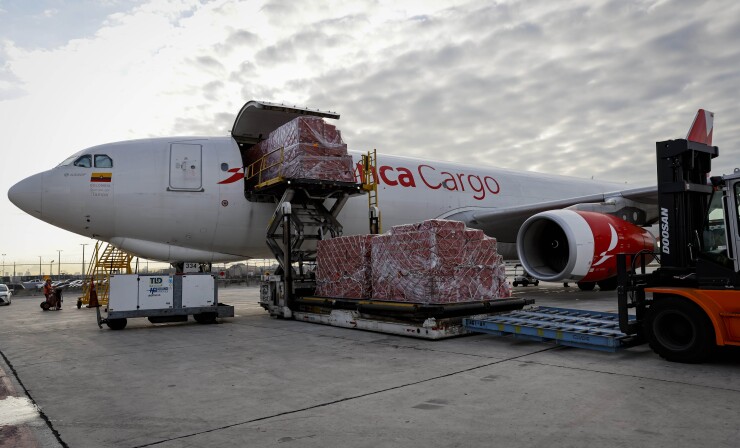Miami-Dade County will bring nearly a billion dollars of aviation revenue refunding bonds for Miami International Airport in a deal supported by growing passenger and freight demand.
Pricing is preliminarily scheduled for Tuesday on $782.4 million of Series 2024A bonds subject to the Alternative Minimum Tax and $141.4 million of Series 2024B bonds not subject to the AMT.
Both series are aviation revenue refunding bonds, intended to refund outstanding Series 2014, 2014A, and 2014B bonds without extensions to the maturities. The AMT bonds will be serial maturities through 2036, and the non-AMT will be serials through 2037, according to an online investor presentation about the deal.
Bloomberg News
The planned bonds are rated A-plus by S&P Global Ratings
As of Monday, the issuer was considering insuring part of the deal but no decision had been made.
“After a period of uncertainty over execution of prior capital plans, [Miami International] Airport has recovered well from the pandemic,” said Joseph Krist, publisher of Muni Credit News. “Demand continues and the Latin American market so important to Miami International Airport continues to be solid. With this deal cleaning up the balance sheet a bit, the rating appears to be on solid ground backed by 2x coverage.”
Both passenger and freight traffic at the airport is well above pre-pandemic levels.
The
Barclays will be the lead underwriter while Estrada Hinojosa, Ramirez & Co., Raymond James, Drexel Hamilton, Baird, JPMorgan, and RBC Markets will co-manage the deal. Hilltop Securities is the airport’s municipal advisor and Greenberg Traurig is its counsel.
Miami International Airport makes major contributions to the economy of southern Florida, said Dominic Calabro, chief executive officer and president of Florida Tax Watch. Many tourists and others come from Europe and Canada and spend a great deal of money during their stay in the region.
Miami International is the second-busiest U.S. airport for international traffic, trailing only New York’s John F. Kennedy International, and number one for international freight, according to the investor presentation.
The airport’s service has improved over the last few decades, Calabro said.
Security for the bonds is net revenue on Miami-Dade County’s port authority properties, which consists of Miami International Airport, three general aviation airports, and one training airport. MIA generates most of the revenue.
The bonds are being sold with a rate covenant that the county will collect rates and charges so that each fiscal year it will cover current expenses and make deposits into the sinking fund in amount not less than 120% of principal and interest requirements.
The airport has $4.9 billion of debt outstanding, excluding commercial paper notes and a Transportation Infrastructure Financing Innovation Act loan, nearly all of which is bond debt.
In explaining its A-plus rating on the bonds, S&P said late last month the airport was a large hub that is “outperforming peers with demand that surpasses pre-pandemic activity” that gives it an “extremely strong market position.” It said the airport has shown financial resiliency and stability through several economic cycles.
The airport serves a
Offsetting the strengths are a “relatively high debt load” with a “very large capital plan” with significant additional borrowing needs and a high airline cost structure.
S&P also noted American Airlines, excluding its subsidiaries American Eagle/Envoy, accounted for 56% of the airport’s enplanements in fiscal 2023. S&P currently rates American Airlines B-plus.
The airport’s enplanement gains compared to pre-COVID numbers are the biggest of any of the top 10 United States airports.
While the airport is exposed to hurricanes and extreme heat, it and the county’s government “have incorporated these risks into capital programs.” The planning activities “can help manage the region’s physical risk exposure but … they may not fully prevent rating pressure from a high-impact event.”
Some of the airport’s financial measures are not as strong as S&P’s medians for A category rated airports. S&P calculated debt coverage is 1.33 compared to 1.60 for the A rated airports. The airport’s ratio of debt to net revenue is 11 times compared to 7.7 times for the A rated airports. Finally, available liquidity to debt is 11.9% compared to 28% for the A rated airports.
In late June Fitch Ratings pointed to similar factors as S&P in explaining its A-plus rating. Additionally, Fitch said its rating reflected “a strong cost-recovery framework” and $4.2 billion in approved capital improvement plan projects, with the potential to expand to $7.4 billion through fiscal 2035.
Fitch noted that the airport’s debt is fixed-rate, fully amortizing and has a final maturity of 2049. The airport’s “1.2x rate covenant and additional bond test are relatively standard for the industry and sufficient given the residual airline use and lease agreement.”
For its part, KBRA attributed its AA-minus rating to similar factors as did Fitch and S&P.
As negatives, it noted “still elevated” cost per enplanement and debt per enplanement ratios “which may be further pressured by up to $2.8 billion in additional debt expected” as part of the capital improvement program.
The airport, in its presentation, said it had brought down its cost per enplanement to $17.39 in fiscal 2024 from a fiscal 2021 peak of $24.73.
Kroll said liquidity levels continued to strengthen in fiscal 2023, driven by years of strong operating performance and the Miami-Dade Aviation Department’s practice of building reserves.
Presenting its own case, the county and airport’s online investor presentation said Miami International Airport had more flights to Latin America and the Caribbean than any other U.S. airport. As of March 31, the airport had a strong cash position of more than $720 million.
During the first six months of fiscal 2024, October 2023 to March 2024, passenger demand was 8% higher than in the same period of fiscal 2023. The airport said it continues to account for a greater share of South Florida air traffic than it did five years ago, both domestically and internationally.
